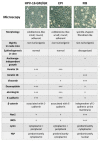Molecular Research on Oral Diseases and Related Biomaterials: A Journey from Oral Cell Models to Advanced Regenerative Perspectives
- PMID: 35563679
- PMCID: PMC9105421
- DOI: 10.3390/ijms23095288
Molecular Research on Oral Diseases and Related Biomaterials: A Journey from Oral Cell Models to Advanced Regenerative Perspectives
Abstract
Oral diseases such as gingivitis, periodontitis, and oral cancer affect millions of people worldwide. Much research has been conducted to understand the pathogenetic mechanisms of these diseases and translate this knowledge into therapeutics. This review aims to take the reader on a journey from the initial molecular discoveries to complex regenerative issues in oral medicine. For this, a semi-systematic literature search was carried out in Medline and Web of Science databases to retrieve the primary literature describing oral cell models and biomaterial applications in oral regenerative medicine. First, an in vitro cell model of gingival keratinocytes is discussed, which illustrates patho- and physiologic principles in the context of oral epithelial homeostasis and carcinogenesis and represents a cellular tool to understand biomaterial-based approaches for periodontal tissue regeneration. Consequently, a layered gradient nonwoven (LGN) is described, which demonstrates that the key features of biomaterials serve as candidates for oral tissue regeneration. LGN supports proper tissue formation and obeys the important principles for molecular mechanotransduction. Furthermore, current biomaterial-based tissue regeneration trends, including polymer modifications, cell-based treatments, antimicrobial peptides and optogenetics, are introduced to represent the full spectrum of current approaches to oral disease mitigation and prevention. Altogether, this review is a foray through established and new concepts in oral regenerative medicine and illustrates the process of knowledge translation from basic molecular and cell biological research to future clinical applications.
Keywords: carcinogenesis; cell transformation; mechanotransduction; mesenchymal stem cells; non-woven; tissue homeostasis.
Conflict of interest statement
The authors declare no conflict of interest.
Figures





Similar articles
-
Biomaterials for Regenerative Medicine: Historical Perspectives and Current Trends.Adv Exp Med Biol. 2018;1119:1-19. doi: 10.1007/5584_2018_278. Adv Exp Med Biol. 2018. PMID: 30406362
-
Designing Biomaterials to Modulate Notch Signaling in Tissue Engineering and Regenerative Medicine.Tissue Eng Part B Rev. 2021 Oct;27(5):383-410. doi: 10.1089/ten.TEB.2020.0182. Epub 2020 Nov 25. Tissue Eng Part B Rev. 2021. PMID: 33040694 Review.
-
Development and application of a 3D periodontal in vitro model for the evaluation of fibrillar biomaterials.BMC Oral Health. 2020 May 19;20(1):148. doi: 10.1186/s12903-020-01124-4. BMC Oral Health. 2020. PMID: 32429904 Free PMC article.
-
A review on endogenous regenerative technology in periodontal regenerative medicine.Biomaterials. 2010 Nov;31(31):7892-927. doi: 10.1016/j.biomaterials.2010.07.019. Epub 2010 Aug 4. Biomaterials. 2010. PMID: 20684986 Review.
-
Biomaterial-Assisted Regenerative Medicine.Int J Mol Sci. 2021 Aug 12;22(16):8657. doi: 10.3390/ijms22168657. Int J Mol Sci. 2021. PMID: 34445363 Free PMC article. Review.
Cited by
-
Advancing Dentistry through Bioprinting: Personalization of Oral Tissues.J Funct Biomater. 2023 Oct 20;14(10):530. doi: 10.3390/jfb14100530. J Funct Biomater. 2023. PMID: 37888196 Free PMC article. Review.
-
Novel In Situ-Cross-Linked Electrospun Gelatin/Hydroxyapatite Nonwoven Scaffolds Prove Suitable for Periodontal Tissue Engineering.Pharmaceutics. 2022 Jun 16;14(6):1286. doi: 10.3390/pharmaceutics14061286. Pharmaceutics. 2022. PMID: 35745858 Free PMC article.
-
Biofabrication Strategies for Oral Soft Tissue Regeneration.Adv Healthc Mater. 2024 Jul;13(18):e2304537. doi: 10.1002/adhm.202304537. Epub 2024 Apr 11. Adv Healthc Mater. 2024. PMID: 38529835 Free PMC article. Review.
-
Characterization of a Stemness-Optimized Purification Method for Human Dental-Pulp Stem Cells: An Approach to Standardization.Cells. 2022 Oct 12;11(20):3204. doi: 10.3390/cells11203204. Cells. 2022. PMID: 36291072 Free PMC article.
-
Impairment of Intermediate Filament Expression Reveals Impact on Cell Functions Independent from Keratinocyte Transformation.Cells. 2024 Nov 26;13(23):1960. doi: 10.3390/cells13231960. Cells. 2024. PMID: 39682709 Free PMC article.
References
-
- Jepsen S., Caton J.G., Albandar J.M., Bissada N.F., Bouchard P., Cortellini P., Demirel K., de Sanctis M., Ercoli C., Fan J. Periodontal manifestations of systemic diseases and developmental and acquired conditions: Consensus report of workgroup 3 of the 2017 World Workshop on the Classification of Periodontal and Peri-Implant Diseases and Conditions. J. Clin. Periodontol. 2018;45:S219–S229. doi: 10.1111/jcpe.12951. - DOI - PubMed
Publication types
MeSH terms
Substances
Grants and funding
LinkOut - more resources
Full Text Sources

